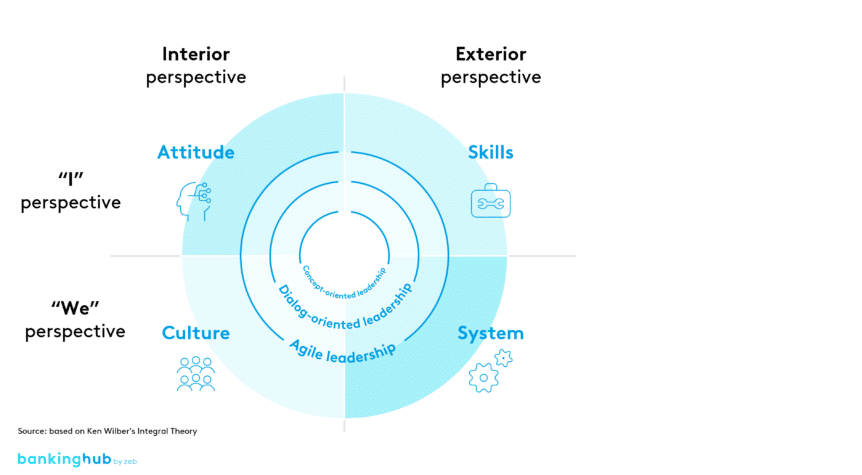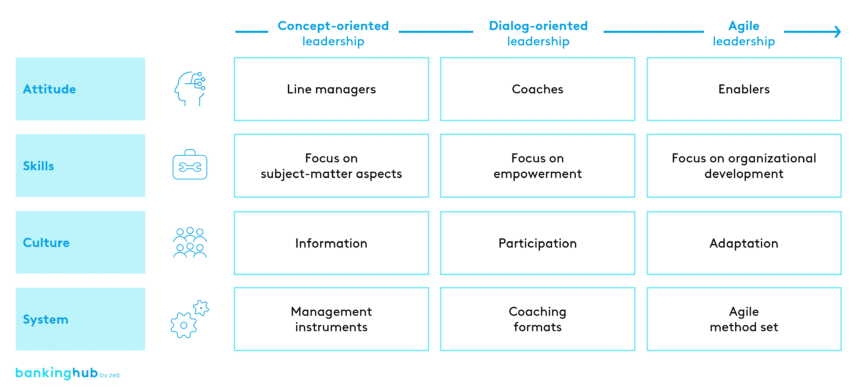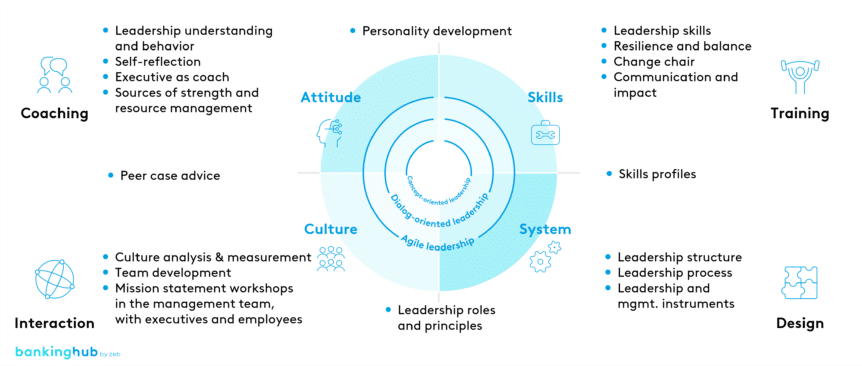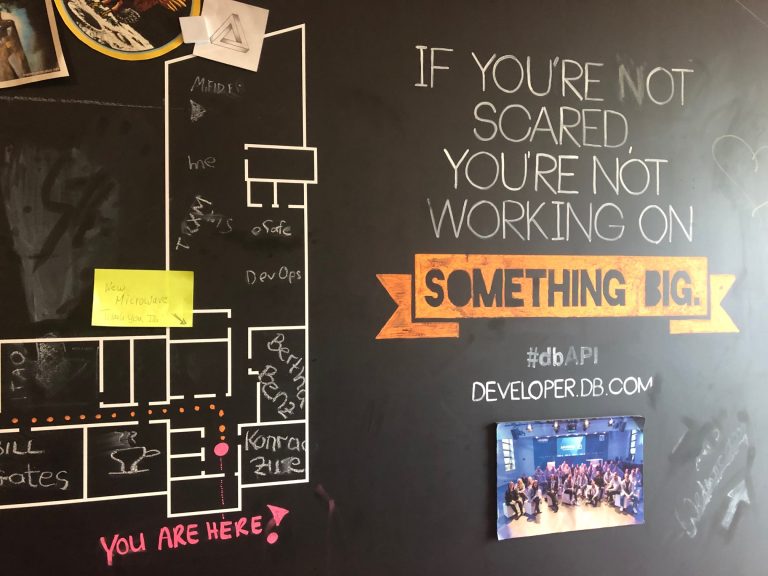Leadership in transformation
Challenges and implications for a future-oriented and agile organization:
-
- Complexity: Transformation is the “new normal”. Crises, trends and technology are exponentially gaining in speed and challenging adaptability.
- Increase in size: With the new wave of mergers, regional banks have become significantly larger. As a result, leadership tasks are changing from operational to strategic and agile activities.
- Search for meaning: Work no longer serves solely to secure a livelihood but should also contribute to a person’s self-fulfillment – people are looking for meaning and like-minded individuals.
- Demographic change: A lack of young talent in the workforce and the aging of society are radically shifting the relationship and power structure between executives and employees. Banks and insurance companies will lose over 30% of their employees by 2030 (see our article on the shortage of skilled workers – an existential threat to banks and insurance companies).
Agile leadership as a success factor
Agile leadership is an important, if not the decisive lever for retaining, attracting and developing staff. Poor leadership is one of the main reasons for employee turnover or dissatisfaction – both of which have an enormous negative impact on business success.
zeb calculations show that on average a resignation, including filling the resulting vacancy, comes with a one-off price tag of around EUR 46,000, while the average cost of efficiency losses due to “quiet quitting” is around EUR 17,000 – per year!
Our understanding of leadership in times of change
The traditional understanding of hierarchy and leadership in regional banks is dissolving. But what is the new direction?
Executives are increasingly feeling the need for a more evolved understanding of agile leadership, but also of their own leadership behavior. They are looking for ways to manage the increased complexity. A road map that provides orientation is required for the effective further development of both individual executives and the leadership system of an organization as a whole.
BankingHub-Newsletter
Analyses, articles and interviews about trends & innovation in banking delivered right to your inbox every 2-3 weeks
"(Required)" indicates required fields
What are the hallmarks of agile leaders?
Based on Ken Wilber’s Integral Theory, we have come up with a framework for effective leadership in change processes which enables us to assess the respective initial situation of an organization and its executives and thus set up a tailor-made development program.
Four fields of action
According to our approach, effective, agile and successful leadership takes place in four fields of action. Only a holistic view of all fields enables the targeted initiation of transformation and change through leadership.
- The fields of action on the left relate to subjective and tangible experiences (from an interior perspective), while those on the right are aimed at objective and visible aspects (from an exterior perspective).
- The fields of action at the top consider the individual (the “I” perspective), the lower ones the collective (the “we” perspective) in the organization.
Three development stages
In our model, leadership evolves along defined development lines. For an effective design of the development program, it is extremely important to determine the starting and target points. We distinguish between three development stages across all four fields of action.
I) What are the characteristics of concept-oriented leadership?
The first stage is concept-oriented leadership. The executive acts as the sender of information with the aim of giving clear instructions and setting guidelines.
Executives are characterized above all by subject-matter skills and expertise. In their role, they are focused on imparting existing knowledge. They expect their employees to implement their ideas. Targets and management tools are designed to guide and develop employees in line with organizational goals. This leadership style is particularly common in hierarchical organizations.
II) What does dialog-oriented leadership involve?
In the dialog-oriented approach, two-way communication develops between executives and employees. Employees are actively involved in decision-making processes and encouraged by their superiors to contribute ideas and get creative themselves.
Executives also see it as their task to create psychological security. They create a working environment in which employees are empowered and supported to take responsibility. In their role as coaches, executives provide impetus, ideas and experiences and thus contribute to a positive corporate culture.
III) What is agile leadership?
At the agile leadership level, power is redistributed and no longer concentrated on individuals.
By distributing creative and decision-making tasks, the agile leadership model focuses on flexibility and adaptation. People with (partial) leadership roles act as enablers in the respective situation and task, not only encouraging their teams, but also inspiring them to be adaptable and self-organized. They contribute to an organizational culture in which the focus is on innovation and continuous improvement and employees decide for themselves how they can best achieve (their) goals. They empower their teams – also by using agile methods and techniques – to learn independently.
Each leadership style has its own strengths and is suitable for different organizational forms and cultures. While concept-oriented leadership primarily promotes stability and predictability, dialog-oriented and agile approaches strengthen in particular commitment and autonomy. Mixed forms between the different approaches are also possible. Ultimately, coordinated interaction in the development stages is crucial.
Suitable formats in the fields of action
The further development and harmonization of leadership in a company requires different but coordinated formats in the four fields of action. These are to be aligned with the status quo and the goals of the organization. It should be noted that all areas can be considered both individually and in combination.
- In the system field, a management structure and a clear understanding of the role of management are designed. The development of consistent leadership and management instruments creates a framework that enables leadership to take effect in the system.
- In the skills field, the focus is on implementing the structure, processes, rules and instruments developed in the system. Leadership and communication skills are learned, applied and further developed through training geared towards the individual or a group.
- The attitude field forms the basis for the behavior and perception of executives in everyday life. In (agile) coaching sessions, executives analyze their personal willingness and capability to change and adapt.
- Ultimately, leadership in the change process can only be fully effective in a culture characterized by openness and trust. The prerequisite for this is psychological security, i.e. trust, respect and the certainty that you can express your own opinion and change – and want to do so. Based on a cultural analysis, common values for leadership can be defined in interactive workshop formats. This creates a sense of community within the organization.
In conclusion, when does agile leadership make sense?
In order to be able to respond to the specific needs of the organization and executives, the first step is to analyze the status quo. To this end, we have developed an analysis method that precisely determines the development stages in all four fields of action. It shows transparently in which areas an organization needs to take measures.
Based on this, a common target picture can be derived for all four fields of action – and agile leadership in times of change can be effectively aligned.














